For part I, see Henry J. Kaiser, Entrereneur.
In 1940, Henry J. Kaiser joined with the Todd shipbuilding company to bid on a contract to build 60 merchant ships for the British government, which desperately needed ships to import supplies during the war. Todd would build half the ships in its East Coast shipyards, while Kaiser would build the other half from a yet-to-be-built shipyard in Richmond, California.
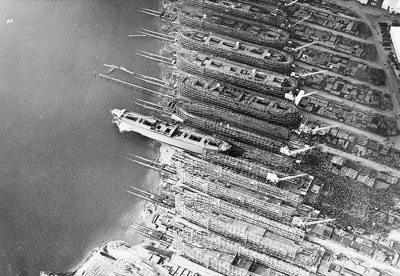
Kaiser’s Oregon Shipyard on Swan Island in Portland.
Kaiser, of course, had never built either a ship or a shipyard in his life, but that didn’t faze him. When he told British and, later, American officials how fast he thought he could build ships, they thought he was delusional — no one had ever built ships that fast. Yet he revolutionized the shipbuilding business, bring assembly line techniques to an industry used to custom, one-off designs.
With the help of other members of the Six Companies, Kaiser built seven shipyards in Portland and Richmond capable of building 58 ships at one time. By the end of the war, these yards had built 1,490 ships, an average of about one per day. Most of the ships were the type of merchant ship known as Liberty ships. But Kaiser also built 12 other kinds of ships, including troop transports, landing ship tanks, and escort carriers. In all, Kaiser supplied more than a quarter of all U.S. ships built during the war.
Large parts of the ships were built as modules that were later fitted together. Where most metal ships before the war had been riveted, Kaiser used welders. Production was not only fast, it was high in quality: while the U.S. government found that more than 20 percent of the ships made by other builders had serious defects, the defect rate of Kaiser ships was less than 10 percent. Welded ships did prove to have some problems in cold waters, but those problems were eventually solved.
When directing crews who were paving roads and building dams, Kaiser learned the value of competition: he would reward the fastest crews in his employ, thus encouraging the others to work faster as well. He quickly adapted this technique to his shipyards, encouraging each one to break the shipbuilding records of the others.
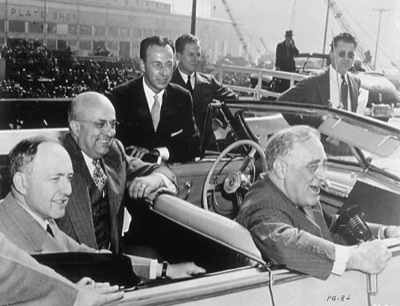
Oregon Governor Charles Sprague, Henry Kaiser, and FDR attending the launch of the first Liberty ship built in just 10 days.
In 1940, ship builders expected to take close to two months from laying a keel to launching a ship, and several weeks more before having the ship ready to turn over to the customer. The Kaiser shipyards were soon launching ships in less than four weeks; the Portland and Richmond yards took turns beating each other’s records. In 1942, the Portland shipyard launched a ship in 10 days, finishing it in just five more. “We could have launched it in eight days,” said Kaiser, “but we waited two days so President Roosevelt could attend the launch.” Not to be outdone, the Richmond shipyard launched a ship in four days and 17 hours.
When the war led to a West Coast labor shortage, Kaiser not only hired tens of thousands of women but recruited tens of thousands of workers from the Midwest and East Coast. “If they know one end of a monkey wrench from the other, we’ll take them as helpers,” said Kaiser. “If they don’t, we’ll label each end.”
Many of the people recruited by Kaiser were black. When some unions tried to bar black workers, Kaiser got the federal government to overrule them. “We do not ask what their color is,” said one of his recruiters.
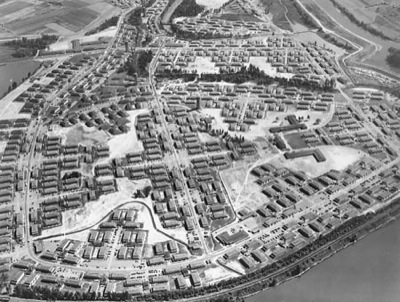
Though hastily constructed, Vanport included many schools, playgrounds, and other amenities.
Such a large migration quickly resulted in housing shortages: for example, the population of Vancouver, Washington more than doubled. When the government failed to immediately act, Kaiser hastily built an entire city of more than 10,000 homes, complete with schools, a library, post office, and a college — the forerunner of Portland State University — on the south shore of the Columbia River. Sometimes called “the miracle city” or “Kaiserville” but officially named Vanport, this was probably the nation’s largest wartime housing project.
Vanport quickly became the second largest city in Oregon, housing as many as 40,000 people — 15,000 of them black (more than in the entire rest of the state). The homes were admittedly poorly built because they were supposed to be only temporary. After the war, most people moved out but about 18,500 remained, nearly a third of them black. In 1948, a dike protecting the city from Columbia River flooding failed and the entire town was wiped out. Fortunately, only 15 people died, and most of the residents relocated into Portland.
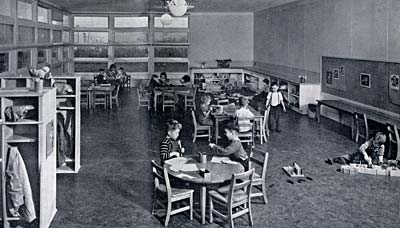
Kaiser’s daycare centers were divided into rooms for 25 children. Some people worried that locating the daycare centers next to shipyards made them vulnerable to Japanese attack, but the location was also convenient for easy drop off and pick up of the children.
In addition to providing health care for all Portland, Vancouver, and Richmond workers, Kaiser provided 24-hour, state-of-the-art daycare facilities for the many women workers who had families. Unlike the medical clinics, these did not survive past the end of the war, partly because the shipyards closed and partly because Kaiser expected most women to stop working after the war.
Among the ships built by Kaiser were 50 escort carriers, sometimes known as “baby flattops” for their small size — a little over 500 feet compared with nearly 900 feet for full-sized World War II carriers. The Navy had given another shipyard a contract to convert 50 cargo ships to escort carriers, but Kaiser was convinced that it could use 100 more and that he could build them from scratch. When the Navy rejected his proposal, he made his pitch to President Roosevelt, who ordered the admirals to give Kaiser a contract for 50.
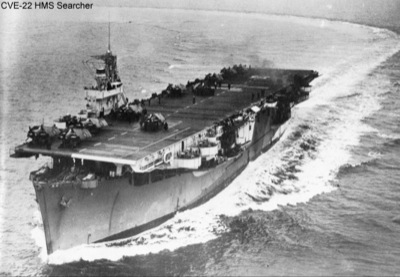
One of Kaiser’s baby flattops, the HMS Searcher, built in the Vancouver shipyard and lend-leased to the United Kingdom. The Searcher survived the war and was used as a cargo ship until scrapped in 1976.
Kaiser’s carriers were sometimes called “Kaiser coffins” for their rumored lack of seaworthiness. In fact, they proved their worth in hunting submarines and in several major sea battles with Japanese forces. In the Battle of Leyte Gulf, a handful of escort carriers held off a major Japanese task force including the Yamato — the largest battleship ever built — and several other battleships. Incidentally, Kaiser earned less profit for each escort carrier he built than he could have earned building other types of ships.
In 1943, an airplane company called Brewster Aeronautical was failing to meet its contract to produce 120 fighter planes per month. Kaiser’s reputation as a miracle worker led the government to put him in charge of the company and get it back on schedule. Working entirely without compensation from the government, Kaiser and four of his employees were able to boost Brewster’s production from 14 to 123 planes per month.
Kaiser had a hand in another famous plane, the Spruce Goose. In 1942, Kaiser proposed that the government build thousands of cargo planes that could carry materials to the front far faster than ships. The government wasn’t interested, partly because of resource shortages and partly because he had never built a plane before. When he partnered with Howard Hughes, the government reluctantly gave them a contract for three planes.
Since Kaiser’s mass production techniques wouldn’t apply to an order for just three planes, Kaiser dropped out. Lacking Kaiser’s discipline, Hughes ended up spending far more money and taking far longer to build one plane than Kaiser had proposed to use building many.
Having brought tens if not hundreds of thousands of new residents to the West Coast, Kaiser worried that the end of the war would bring high rates of unemployment. To prevent this, he proposed to bring new industries to the West, starting with steel.
The government wanted to build a steel mill in Utah, near abundant deposits of coal and ore, but was leery of building one in California, where it could be vulnerable to Japanese attack. So the government contracted with U.S. Steel to build the Geneva, Utah, steel mill for $200 million. At Kaiser’s insistence, it loaned him $100 million to build a mill in Fontana, California. He also built a mill to refine magnesium, which was needed as a light-weight substitute for steel.
After the war, the government sold the “surplus” Geneva mill to U.S. Steel for about 20 percent of its value. Kaiser argued that it was only fair for the government to reduce his outstanding loan for the Fontana mill, but the government wouldn’t agree and in 1951 he repaid it in full.
Kaiser’s ship building and other war efforts made him an international celebrity. He was frequently featured in Time, Life, and other magazines. After the war, he used his status to expand into several new industries.








Enjoying this very much, Randal.
Ditto. Henry Kaiser stands as one of the forgotten heroes of American industry, both for his entrepreneurship and innovation and the way he looked out for his workers. You could say it was a sort of benevolent paternalism, but it did work.
Pingback: » The Antiplanner
http://www.youtube.com/watch?v=_cDF_DQ6ZZs&NR=1